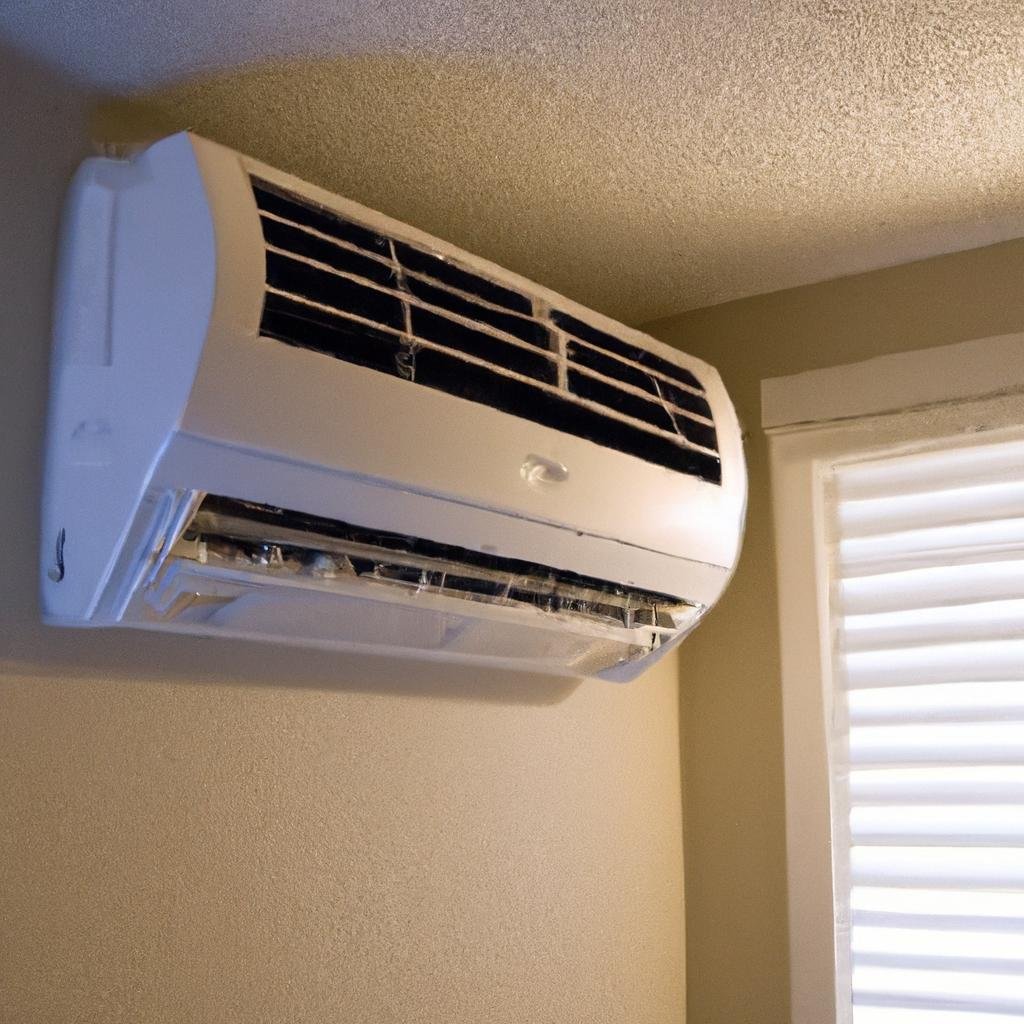Hello there, friendly DIY enthusiasts and curious homeowners! Have you ever found yourself staring at your home’s interior wall, daydreaming about installing a ductless mini-split there? Is it even possible, you wonder, or is it just another elusive figment of your home improvement imagination? If these questions are buzzing in your head like eager little bees, well, buckle up, my friends! You’re about to embark on a delightful journey of discovery through the realm of HVAC configurations, and by the end of this article, you’ll have all the answers you need to satisfy your inquisitive mind. So let’s dive in and decipher this ductless mini-split mystery together!
Exploring the Possibility: Installing a Ductless Mini-Split on an Interior Wall
The idea of installing a ductless mini-split on an interior wall may have crossed your mind. And why not?’ They offer great benefits like better cooling efficiency, easier installation, and aesthetic versatility. But patiently hold your horses because there are important things to consider before jumping on this.
First off, the primary consideration is your room structure and layout. The indoor unit of a mini-split systems is ideally mounted high on an exterior wall that can support the unit’s weight and accommodate the refrigerant lines, condensate drain, and electrical connections. But it doesn’t rule out possibilities of installation on an interior wall, especially if the house layout allows it. Remember, it’s essential to ensure that the wall can bear the weight of the unit, with suitable space for correct airflow and clear access for maintenance.
Next, let’s talk about piping logistics. The indoor unit must be connected to the outdoor unit via refrigerant lines, where one is for taking in cool air and the other for expelling warm air. If mounted on an interior wall, the piping might be longer, and extra efforts would be needed to dodge the house’s structural elements. Depending on your tolerance for aesthetics, the pipes may also need to be concealed in the walls or ceilings resulting in higher installation costs. To summarise, installation on an interior wall is indeed technically possible – but it might not be the most practical or cost-effective option.
| Pros | Cons |
|---|---|
| May be aesthetically pleasing if it integrates well with your interior decor | May require longer piping and more complex installation |
| May provide effective cooling if well-positioned | Possibility of higher installation costs |

Getting Technical: An In-depth Look at How Interior Wall Installation Works
Many homeowners are now opting for ductless mini-splits as efficient and versatile alternatives to traditional HVAC systems. But, the question arises, can these be installed on an interior wall? The answer is a resounding yes. Ductless mini-splits are highly versatile and can be strategically installed on an interior wall where they effectively provide zoned cooling and heating. Through indoor air handling units and external compressors, the system can effortlessly manage a comfortable indoor atmosphere without any cumbersome ductwork.
The process of installing a mini-split on an interior wall is quite straightforward. It begins with mounting the air handling unit at a desired location. The technician drills a small hole in the wall for the conduit, which includes power cable, refrigerant tubing, suction tubing, and a condensation drain. Then, the outdoor compressor unit is fixed at a suitable distance from the indoor unit, typically on the ground or over a wall bracket. The connection between the indoor and outdoor units is made through the conduit. This installation process ensures minimal impact on the home’s aesthetic appeal and structural integrity. If the idea of hidden ductwork appeals to you, then ductless mini-split systems are a neat solution.
- Placement: Choose a position on your wall where the unit will not obstruct any pathways or furniture layouts. The system should be mounted at least five feet from the floor for better performance.
- Drilling: A 3-inch hole needs to be drilled in the wall, through which the conduit will pass. Take care to ensure that this hole is straight and not angled.
- Mounting: The indoor unit is then mounted on a plate which is affixed to the wall. The outdoor compressor unit is installed at an appropriate distance from the indoor unit.
- Connection: Both units are connected through the conduit, and all open spaces are sealed for energy efficiency.
| Pros of Ductless Mini-Split Systems | Cons of Ductless Mini-Split Systems |
| High Energy Efficiency | Higher upfront cost |
| Provides zoned cooling and heating with flexibility | Requires regular cleaning and maintenance |
| Adaptable location selection | Sometimes perceived as less visually appealing than other options |

Maximizing Comfort: Choosing the Best Location for your Mini-Split
If you’re considering a ductless mini-split system for your home, you may be puzzled about the best location to place your unit. Surprisingly, as unconventional as it may seem, installing a mini-split on an interior wall can actually be beneficial! Although traditionally, mini-splits are placed on exterior walls for easy access to the outside unit, an interior wall can provide a more central location. This allows for more uniform air distribution and decreases the chances of uneven cooling or heating.
However, this is not a one-size-fits-all solution, as several factors may influence the decision. To help you decide, consider these points:
- Room Size: Larger rooms might require more strategic placement to ensure even temperature distribution.
- Insulation: An interior wall might be a better choice if it is well-insulated. This can prevent energy loss and improve efficiency.
- Obstacles: Ensure the selected spot is free from obstructions like furniture or cabinetry and at a distance from electronic devices.
- Aesthetic appeal: Interior wall installations can be more aesthetically pleasing, as you can better hide wiring and the outdoor unit.
Remember to always consult with a professional before making the final decision. They can assist in evaluating your space and finding the optimal placement for your mini-split.
| Advantages | Disadvantages |
|---|---|
| Central position for balanced cooling/heating | Potential difficulty in accessing outdoor unit |
| Better energy efficiency with good insulation | May require additional piping |
| Increased aesthetic appeal | Higher installation cost |

Bringing Expertise Into Your Home: Essential Tips and Professional Advice for Mini-Split Installation
So you’ve chosen your ductless mini-split system and now you’re left with the question of where to install it. Yes, it is possible to install a mini split on an interior wall and in fact, this is often a preferred location for many homeowners because it avoids the direct influence of outside weather, can provide more uniform conditioning and reduces the outdoor noise intrusion.
The most popular locations for interior wall installation are typically the highest and lowest points in the room. These spots provide the greatest distribution of air, due to their proximity to either the ceiling or the floor. The ideal location, however, will vary according to a room’s layout, its source of heat gain or loss, and the homeowner’s aesthetic preference. Here are some major points to consider while making the decision:
- Available wall space: Consider the unit’s dimensions and ensure there’s adequate wall space to mount the system.
- Obstructions: Be aware of any nearby doors, windows, or furniture which could obstruct the airflow.
- Insulation: Check the insulation of the interior wall. Poorly insulated walls may hinder optimal performance of the mini-split.
| Impact Point | Consideration |
|---|---|
| Condensate drain | Condensate drains must be appropriately placed to prevent moisture and mold issues. |
| Refrigerant & Electrical lines | These lines may need to extend a greater distance if your unit is installed on an interior wall – affecting budget and complexity. |
Consider consulting with a professional HVAC installer to make sure you select the best possible location for your ductless mini-split system. Remember, correct installation is crucial for optimal operation and longevity of your system.
Q&A
Q: What is a ductless mini-split?
A: A ductless mini-split is a type of heating and air conditioning system that doesn’t require the usage of ducts. It consists of two primary parts: an outdoor compressor/condenser and an indoor air-handling unit.
Q: Can one install a ductless mini-split on an interior wall?
A: Absolutely! Installing a ductless mini-split on an interior wall is not only possible but can make a lot of sense depending on the design and layout of your home.
Q: Does placement of the mini-split matter?
A: The placement of the mini-split can affect how efficiently it heats or cools your living space, so you should always bear this in mind. Even though it’s possible to install it anywhere, choosing an optimal place considering convenience, aesthetics and performance is crucial.
Q: Are there any advantages to installing it on an interior wall?
A: Indeed there are. Interior wall installation can help distribute conditioned air more evenly throughout the room, especially when carefully positioned. When noise is a concern, installing on an interior wall can also minimize sound as these walls usually have more insulation.
Q: What could be the possible drawbacks?
A: The main challenge could be running the refrigerant line from the outdoor portion of the system to the indoor unit, especially if the distance between them is substantial. The aesthetics might also be an issue for some, as the unit will be visible inside the room.
Q: Should I consider professional help for the installation?
A: It is recommendable to have a professional HVAC contractor install your ductless mini-split system. They have the necessary experience and expertise to ensure it’s done right, maximizing the efficiency and longevity of your system.
Q: Could a ductless mini-split be used in any type of property?
A: Ductless mini-split systems are highly versatile. They can be installed in residential homes, commercial properties, and even in vintage buildings where conventional ducted systems might not be best suited. They’re a great choice for providing comfortable, energy-efficient heating and cooling.
Closing Remarks
And there you have it, folks! You’ve journeyed through the realm of ductless mini-split installation on interior walls, and hopefully, we’ve solved most of the mysteries for you. So, whether you’re a brave DIY enthusiast or prefer the assurance of professional hands, rest assured that an interior wall can indeed be a hospitable home for your new ductless mini-split. Such flexibility is why these nifty little devices have revolutionized modern comfort. So go on, my dear reader, challenge the traditional notion of HVAC systems and embrace the charm of the ductless mini-split. Let the warmth and cool air flow, right where you want it. Until our next DIY adventure, happy installing!

